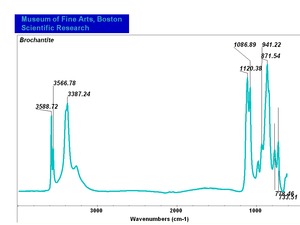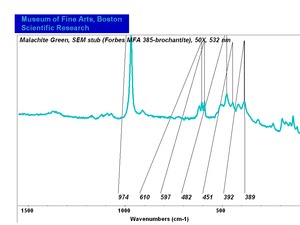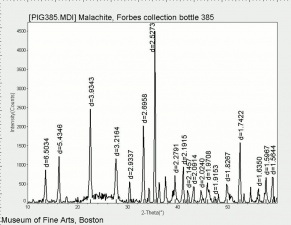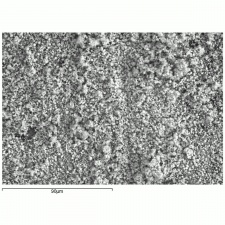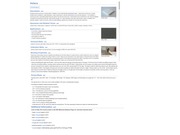Difference between revisions of "Main Page"
| Line 3: | Line 3: | ||
The Conservation and Art Materials Encyclopedia Online (CAMEO) is a database that compiles, defines, and disseminates technical information on the distinct collection of terms, materials, and techniques used in the fields of art conservation and historic preservation. First developed as a materials database in 1997 at the Museum of Fine Arts, Boston it has expanded to include several reference collections and collaboration with different institutions. | The Conservation and Art Materials Encyclopedia Online (CAMEO) is a database that compiles, defines, and disseminates technical information on the distinct collection of terms, materials, and techniques used in the fields of art conservation and historic preservation. First developed as a materials database in 1997 at the Museum of Fine Arts, Boston it has expanded to include several reference collections and collaboration with different institutions. | ||
| + | |||
| + | To use CAMEO, select any of the databases on the left or simply search by entering text into the search box at the top right. By using this encyclopedia, you are agreeing to the terms stated in the [[User agreement]]. | ||
*'''Materials database''' contains chemical, physical, visual, and analytical information on historic and contemporary materials used in the production and conservation of artistic, architectural, archaeological, and anthropological materials. | *'''Materials database''' contains chemical, physical, visual, and analytical information on historic and contemporary materials used in the production and conservation of artistic, architectural, archaeological, and anthropological materials. | ||
| Line 41: | Line 43: | ||
Stayed tuned to this page for databases now in progress for Asian Textiles and Japanese woodblock prints. | Stayed tuned to this page for databases now in progress for Asian Textiles and Japanese woodblock prints. | ||
| − | |||
| − | |||
| − | |||
| − | |||
| − | |||
| − | |||
| − | |||
| − | |||
| − | |||
Revision as of 16:54, 17 June 2020
Conservation & Art Materials Encyclopedia Online (CAMEO)
The Conservation and Art Materials Encyclopedia Online (CAMEO) is a database that compiles, defines, and disseminates technical information on the distinct collection of terms, materials, and techniques used in the fields of art conservation and historic preservation. First developed as a materials database in 1997 at the Museum of Fine Arts, Boston it has expanded to include several reference collections and collaboration with different institutions.
To use CAMEO, select any of the databases on the left or simply search by entering text into the search box at the top right. By using this encyclopedia, you are agreeing to the terms stated in the User agreement.
- Materials database contains chemical, physical, visual, and analytical information on historic and contemporary materials used in the production and conservation of artistic, architectural, archaeological, and anthropological materials.
- Dye Analysis
- Fiber Reference Image Library
- Forbes Pigments
- Uemura Dye Archive
- Asian Textile Database
- Ukiyo-e Colorant Database
USING CAMEO
Please enter your search term in the box on the upper right. Press the Go button for an exact match to an English material name. Press the Search button for a full text search of the records including all non-English (French, Spanish, Italian, Portuguese, German, Dutch, Greek, Polish, Hungarian, etc.) synonyms in the MATERIALS database. CAMEO has recently undergone a major transformation to a wiki based platform. As is inherent in wikis, some databases and pages contained within CAMEO are 'works in progress'. Pages, data, and information will be added and updated on a continuing basis. By using this encyclopedia, you are agreeing to the terms stated in the User agreement.
NEWS
UPDATED SPECTRA
A concerted effort is currently underway to evaluate and upgrade the analytical spectra that are presented in CAMEO. This primarily includes examining current Infrared and Raman spectra to ensure their accuracy as well as to provide images with wavelength markers for the major peaks. See for example the Brochantite slider gallery shown on this page. For this particular sample, the Forbes pigment jar was labeled ‘Malachite Green’, but all analysis techniques confirmed its identity to be brochantite. One of our efforts has been directed toward correctly identifying the pigments in the Forbes reference set. The major work on MFA contributions is being done by Dr. Erin Mysak. Concurrently, Dr. Abed Haddad, the David Booth Fellow in Conservation Science from the Museum of Modern Art in New York City is examining and contributing to the Raman reference set.
Funding for these updates were received from:
- Sotheby’s Scientific Research Department
AIC MATERIALS WORKING GROUP
The Materials Selection and Specification Working Group (MWG) at the American Institute for Conservation (AIC) is leading an effort to provide a resource bank of information that will help develop best practices in selection of materials used in the preservation, transport, and display of cultural heritage. CAMEO has been designated as the platform for the consolidated information on materials with new sets of information added under the headers: Applications, Personal Risks, Collection Risks, Environmental Risks, Working Properties, and Forms/Sizes. The ‘Additional Information’ field will contain links to the Oddy Test results residing in the AIC Wiki. The ‘Environmental Risks’ section will be populated with information developed as part of the recently funded NEH grant for Life Cycle Assessment of materials and treatments used in cultural conservation. CAMEO will also provide links to the Life Cycle Assessment tool that will enable the comparison of carbon footprints for over 3000 materials.
FUTURE DEVELOPMENTS
Stayed tuned to this page for databases now in progress for Asian Textiles and Japanese woodblock prints.
